how to create an original character
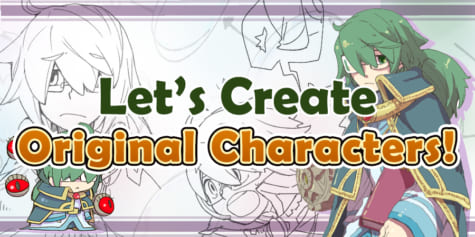
We've all had that urge to start creating your own original work but then worry starts to creep in... Just what kind of character should you make? This tutorial takes a look at a process for creating an original character.
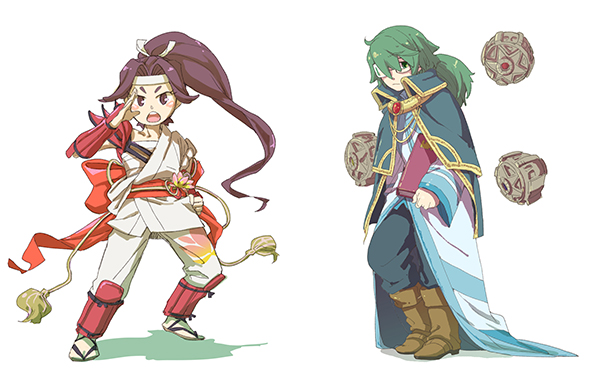
First, let's think about what's on the inside, the core of a character.
The most important part of a character is their personality.
You might be thinking, "I'm an illustrator, and I'm not especially interested in drawing manga, so I don't need to give my character a personality." However, a character's outward appearance alone doesn't help you imagine the kind of pose or expression they will have.
For that, you need a personality. Without one, you can end up drawing the same character over and over again. If giving a character a soul makes it "original," then a character's personality is their soul.
Establishing the main personality traits and branching out
However, it's hard to just start deciding character traits. So first, we'll decide on their main traits and slowly branch out from there.
First things to decide upon
- In a story, what kind of role would this character have? (Protagonist, antagonist, supporting role, etc.)
- What kind of background would they have? Are they comic book characters, a character with a worldview from the inside, are they designed around a specific motif?
- Sex, gender, age
- Personality
Out of all of these, personality is the most important. That being said, let's try not to add too many ideas all at once, but instead, aim for about two or three main traits.
In one word, how would you describe your character? Think of foundational character traits such as selfish, cold, emotional, passionate, etc. Once decided, we can then start branching out from the main trait.
For example, "selfish" can be broken down further into "picky" or "hated by others," etc. This keeps the character consistent. Without consistency, it's hard to know how a particular character, such as someone that's "easily angered" but "nice," will react in a particular situation. This results in confusion and a character that leaves little to no impression on the audience.
● Conflict leading to personality
Establishing an original character's main trait and branching out is just the beginning. Now we can move onto something that will make the character appealing. This is where we need to capture their personality twists and their backstory.
A twist in your character may seem like an inconsistency, but it is an important component of a character's depth. When a character shows a side of themselves that is against their main traits, such as a selfish person that becomes patient in certain circumstances, or a strong person that sometimes gets upset, it makes the character seem more human.
However, if the twist is excessive, it can threaten the core of the character, so it's best to create contradictions and conflicts that only occur in specific situations such as in the above examples.
The backstory is an experience in your character's past that informs their present. Examples of this include the character's family structure, the kind of life they led, any turning points, and so on. If you think about the character's background that the audience normally doesn't see, this helps create believable foundations for their current actions.
Take a 16-year-old character. What were their 16 years of life like? Knowing this allows you to ground a vague character to something concrete, making them much more realistic.
So let's make an original character! We'll make one guy and one girl with fantasy character motifs.
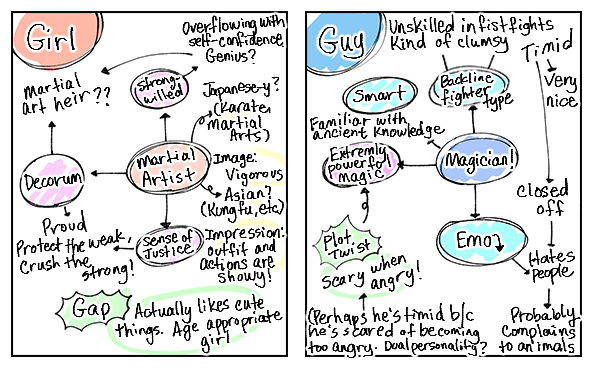
Let's make the guy a meek magic user and the girl a noble martial artist. We'll use these personality traits as a guide when drawing our characters. This will help bring out their personality in our drawings.
You don't have to have a solidified idea from the start. It's okay to gradually build up from a base idea as you draw so don't worry about deciding every single facet of their personality now. As you draw, you will inevitably think up and add new ideas and further branch out your characters.
Creating the general appearance
With the interior of the character created, it's time to move onto the exterior.
We will want to create an outward appearance that doesn't contradict the character's inward personality. For example, a sweet, friendly lolita fist fighter doesn't really work. It theoretically could work as a twist, but on the surface level, it feels contradictory.
Let's branch out from main ideas, just like how we did with the personality.
Things to decide when creating a character's outward appearance:
- Body shape (height, weight, breast size, muscles, any physical trait that pops out)
- Facial characteristics (Eye shape, facial contour)
- Hair
- Clothing
- Facial expression, pose, movement
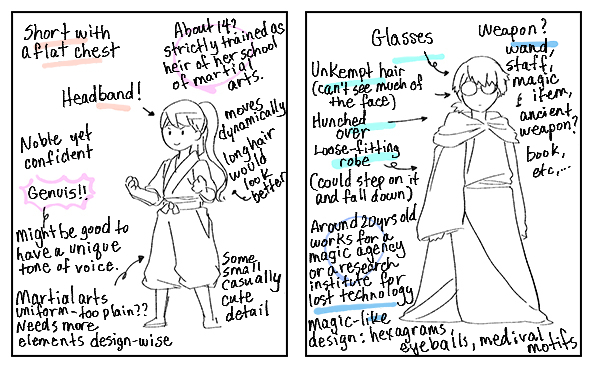
Take note of the above list of things as you draw.
The guy is a magic user so he'll have a robe, he's short, and he wears glasses which altogether gives off a meek impression. The girl will wear a martial arts uniform and have a Japanese appearance.
It's fine if at this point your sketch just looks like a typical character you can see anywhere. At this stage, a rough base is all we need.
Create a strong personality using outward appearance as well
Once your main idea is decided, let's start brushing up the outfits and appearances. This is where our character will become an "original character" rather than just a generic idea.
The key component when drawing outward appearances is to create something visually memorable to your audience, such as a color scheme or a motif. For example, if the motif is a butterfly, we could add butterflies to their clothing and accessories. Even with a character dressed in a typical high school girl uniform, we could devise something characteristic of their personality, such as a hairstyle or a hand-held item.
A good way to think about key components is, if you were to draw your character as a chibi, this characteristic should still stand out. See the below images for examples of this.
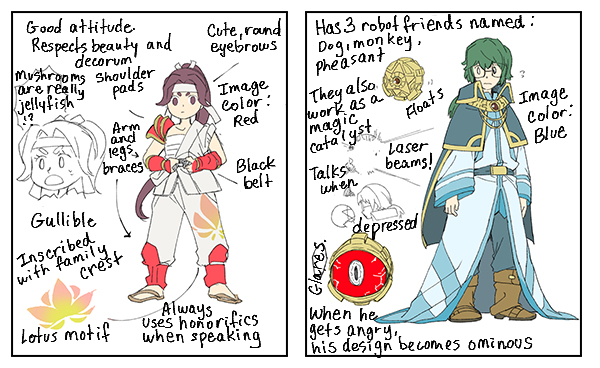
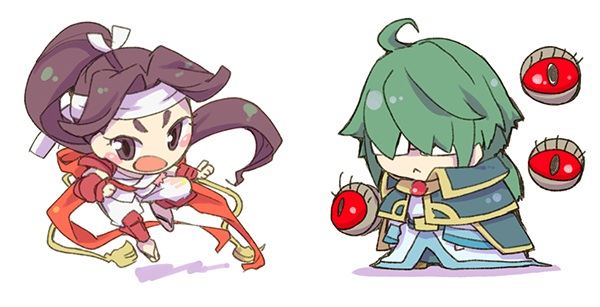
Draw movement and poses that go along with the character personality traits as well. For example, a tomboyish girl could wear something that allows for free movement such as pants, and stand in masculine poses.
Individualism and exaggeration
Let's talk about exaggeration in terms of personality and outward appearance.
This is a work of fiction so, if it's only filled with typical characters you would see anywhere, it won't be appealing to your audience. Main characters should be outwardly intriguing. Let's say you have a strong character that secretly likes cute things – you could express this in their outward appearance with a long, cascading, voluminous ponytail.
Thinking along these lines will help you create a character with personality.
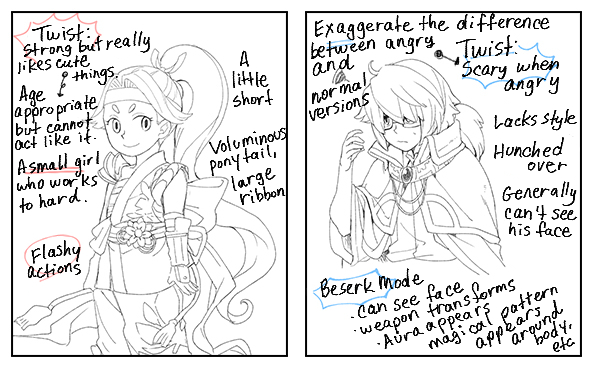
After creating your character, let's set it into motion
Let's draw the character we created with various expressions and poses that compliment them.
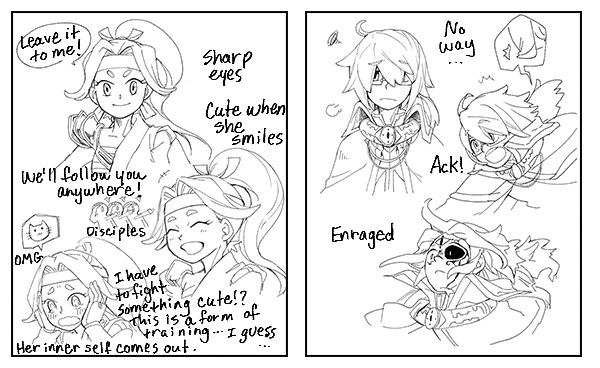
Smiling because they are happy, crying because they are sad, let's try not to be bound by this singular pattern when we create our character's expressions. Laughter and crying should be unique to every character. Think of it like this, if there is a quiet or bashful character present, our character might not have a typical embarrassed reaction, but instead hide their embarrassment with anger.
If it's difficult to make an outward characteristic, make their personalities more interesting.
For example, characters wearing uniforms are particularly challenging to add outward characteristics (but I still like to imagine what kind of jewelry or t-shirts they might be wearing aswell). In such cases, it's important to focus even more on their personalities.
You can also try weaving together emotional subtleties, along with realistic and unrealistic personality traits to create something special. Start with one original character, then create more and have them interact with one another, then grow your story, and create a new world!
I invite you to take this opportunity and create your unique original characters.
Author: Tokio (ときお)
Illustrator: Suga (スガ)
Creator: BeCom
how to create an original character
Source: https://www.clipstudio.net/how-to-draw/archives/154434
Posted by: craighatiagoorah.blogspot.com

0 Response to "how to create an original character"
Post a Comment